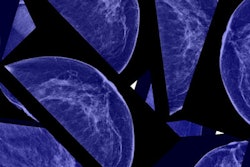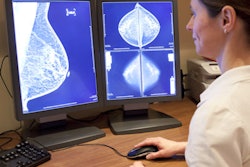
Breast cancer screening with digital mammography is effective at finding life-threatening cancers early without increasing recall rates, according to a study published December 11 in Radiology. The findings offer further evidence of the benefits of routine screening mammography.
"Our study clearly shows the benefits of digital mammography in terms of overall cancer detection rate -- and that this benefit is achieved without an increase in recall rates," said lead author Roger Blanks, PhD, of the Nuffield Department of Population Health at the University of Oxford. "This finding is particularly important as digital images provide increased visualization for features associated with cancers such as high-grade ductal carcinoma in situ [DCIS] and grade 1 and grade 2 invasive cancers."
11.3 million strong
 Roger Blanks, PhD, from the University of Oxford.
Roger Blanks, PhD, from the University of Oxford.The U.K. National Health Service Breast Screening Programme (NHSBSP) was established in 1987. Starting in 2008, digital mammography began to replace film-screen mammography, and by 2011, 80% of the program's sites had at least one digital mammography device. By 2014, 95% of the program's sites were fully digital.
Blanks and colleagues sought to evaluate the effect of digital versus film-screen mammography on cancer detection using data from the 80 facilities of the NHSBSP. The study included 11.3 million screening exams in women between the ages of 45 and 70. Of these, 2.3 million were routine first screening exams in women ages 45 to 52, and 9 million were subsequent screening exams in women ages 53 to 70. Among all of the exams, 86,443 cancers were identified, for a rate of 7.7 per 1,000 women screened.
Digital mammography increased the overall cancer detection rate by 14%, compared with film-screen mammography, and digital mammography also found more invasive cancers, according to the researchers. In addition, among women between the ages of 45 and 52 undergoing their first breast cancer screening exam, digital mammography increased the cancer detection rate by 19%. Among women between the ages of 53 and 70, the incident cancer detection rate increased by 13%.
| Effectiveness of breast screening with digital mammography in U.K. | ||||
| Early implementation period (2009-2011) | Middle implementation period (2011-2014) | Late implementation period (2014-2016) | p-value for change between early and late periods | |
| Use of digital mammography across NHSBSP facilities | 34.6% | 81% | 98% | -- |
| Mean recall rate | 3.8% | 4% | 3.9% | -- |
| Cancer detection per 1,000 women screened | 7.3 | 7.8 | 8 | 0.001 |
| Invasive cancers detected per 1,000 women screened | 5.8 | 6 | 6.1 | 0.001 |
| Grade 1 and 2 cancers detected per 1,000 women screened | 4.5 | 4.8 | 5 | 0.001 |
| Grade 3 cancers detected per 1,000 women screened | 1.2 | 1.2 | 1.2 | 0.81 |
| High-grade DCIS detected per 1,000 women screened | 0.81 | 0.93 | 1 | 0.001 |
Unfortunately, digital mammography did not improve the detection of grade 3 cancers, Blank said.
"We were disappointed that digital mammography showed no increase in the detection of grade 3 invasive cancers," he told AuntMinnie.com. "These are difficult but important cancers to detect. Radiologists therefore need to explore the use of digital processing in more novel ways, or further explore the use other modalities such as MRI or ultrasound to increase sensitivity for these cancers."
Lessons learned?
The study results show that digital mammography leads to improved cancer detection rates without affecting the recall rate, and that it does so for both prevalent and incident screening exams, wrote Dr. Christoph Lee and Dr. Janie Lee, both from the University of Washington, in an editorial that accompanied the study. But the findings should be taken with a grain of salt.
"The sheer size of the study population ... provides strong support for improved cancer detection without worsening recall rates as a result of the transition from screen-film to digital mammography," Lee and Lee wrote. "However, these observational results run counter to published trial results comparing the accuracy of digital to screen-film mammography."
They also noted that some might question whether examining the transition to digital mammography in an era of digital breast tomosynthesis (DBT) is useful. But assessing the transition from film-screen to digital mammography can shed light on the effect of shifting from digital mammography to DBT.
"We can learn quite a bit from studying the transition between screen-film to digital mammography and apply the lessons learned to our current efforts for assessing the impact of transitioning from digital mammography to DBT," the two concluded.




















